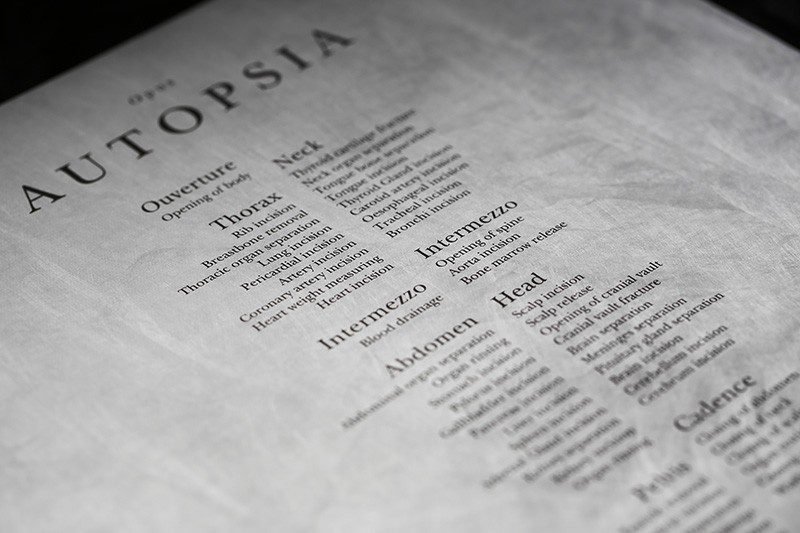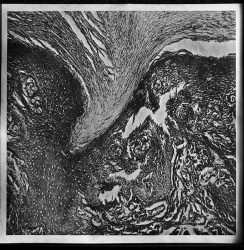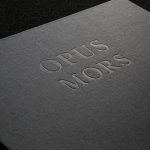JACOB KIRKEGAARD – OPUS MORS
If you are familiar with the work of Danish sound artist Jacob Kirkegaard you’ll know that in his work he often explores extraordinary concepts. 4 Rooms / Aion for example: exploring the sound of deserted rooms in Chernobyl. Or Labyrinthitis: the sound of the inner ear, generating ‘otoacoustic emissions’ in the ears of the listeners. Sabulation, presenting the Singing Sands from the desert of Oman. Eldfjall: volcanic vibrations in the earth recorded in Iceland…
Just check the Works page of his website to find out that most of his installation and exhibition work is not even released as a regular audio release.
Kirkegaard’s projects are always meticulously researched, perhaps even scientifically, and recorded in ways that are hardly imaginable – but it is never with sensationalist intentions. Kirkegaard presents the sounds of our surrounding world in a way that usually cannot be heard (or are neglected) – a bit like looking through a microscope.
“Complex phenomena and current conditioned are portrayed through composition, installation, video, and photography. Rather than providing answers, his portrayals create spaces for reflexion.”
For an artist exploring all things of earth and life like he does, it should be no surprise that he ventures where others dare not go: such as exploring death and the rituals that surround it. Death is “one of the existential the natural aspects of being alive” and thus should be part of our everyday life. But in many cultures it isn’t: the subject of death and decay is controversial and a taboo for many.
Opus Mors (the Work of Death) – a sound work on four significant environments for the immediate post-mortem – may be confronting or provocative to some listeners, which is why Kirkegaard looked for a way to release this work so that it would not be too easily copied and (illegally) distributed and reach an audience that wasn’t prepared for it or did not consciously chose to listen to it.
The result: an exclusive limited (250) boxset release of 4LP’s, packed in an archival handmade box, bound in linen and embossed, including 5 prints. (And of course priced accordingly: to check for the price and availability you must contact Jacob Kirkegaard directly).
“Four sound environments that the human body commonly will be surrounded by or exposed to in the immediate post mortem: a morgue, an autopsy, a cremation and the decomposition – events that no one will ever get to sense on their own bodies because of the very fact of death.”
Whether you find these recordings uncomfortable listening or not depends on your personal attitude towards the subject and its context. Opus Morturarium (humming slow and deep tones recorded within the facilities that keep corpsed cold) and Opus Crematio (recorded within the cremation oven revealing the sound of the oven as of heard from the inside) are industrial environmental soundscapes that can easily be experienced as relaxing (especially Opus Morturarium: I could easily sleep to that humming sound).

Opus Autopsia and Opus Putesco are considerably less comforting but at the same time even more fascinating. Opus Autopsia, as the name suggests, is a set of near-field (!) sound recordings of a full autopsy. With an Ouverture (‘Opening of body’) and an Intermezzo (‘Opening of spine/Aorta Incision/Bone Marrow release’) it’s a symphony of fragments that’ll ignite your fantasy – probably to be happy that this is just audio, and not also video.
The concluding Opus Putesco (‘putesco’ means ‘rot’) is recorded at a forensic study facility where (donated) corpses are placed in an enclosed nature area to decompose while being studied. The recordings were made “with measurement microphones placed 1 cm above – as well as with vibration sensors inside the corpses”. The delicate nibbling sounds are quite an experience, especially with the flies that seem to buzz around your own head.
I must admit that it was the concept of this quite off-limit aural area that attracted me in the first place, but there is nothing like that sensation in the recordings. Kirkegaard treats his subject with respectful distance (which is a bit of a contradiction when using near-field microphones, but I guess you understand what I mean), not unlike the scientists studying the natural decay of the body, or the pathologist performing the autopsy. It’s up to the listener to approach these recordings with the very same respect.
Ultimately, this is the environmental recording project concept that sómeone had to realise, and Jacob Kirkegaard is probably the only one that could pull this off in the way he did. I’d say this is his magnum opus, even though it will clearly nót be everyone’s cup of tea.
(Disclaimer: this post was written based on the release information and small fragments from each of the four LPs in this set that were kindly provided by Jacob Kirkegaard – so actually I’m not familiar with the full-length release which may contain some surprises not mentioned above).
JACOB KIRKEGAARD – OPUS MORTURARIUM (FRAGMENT)



